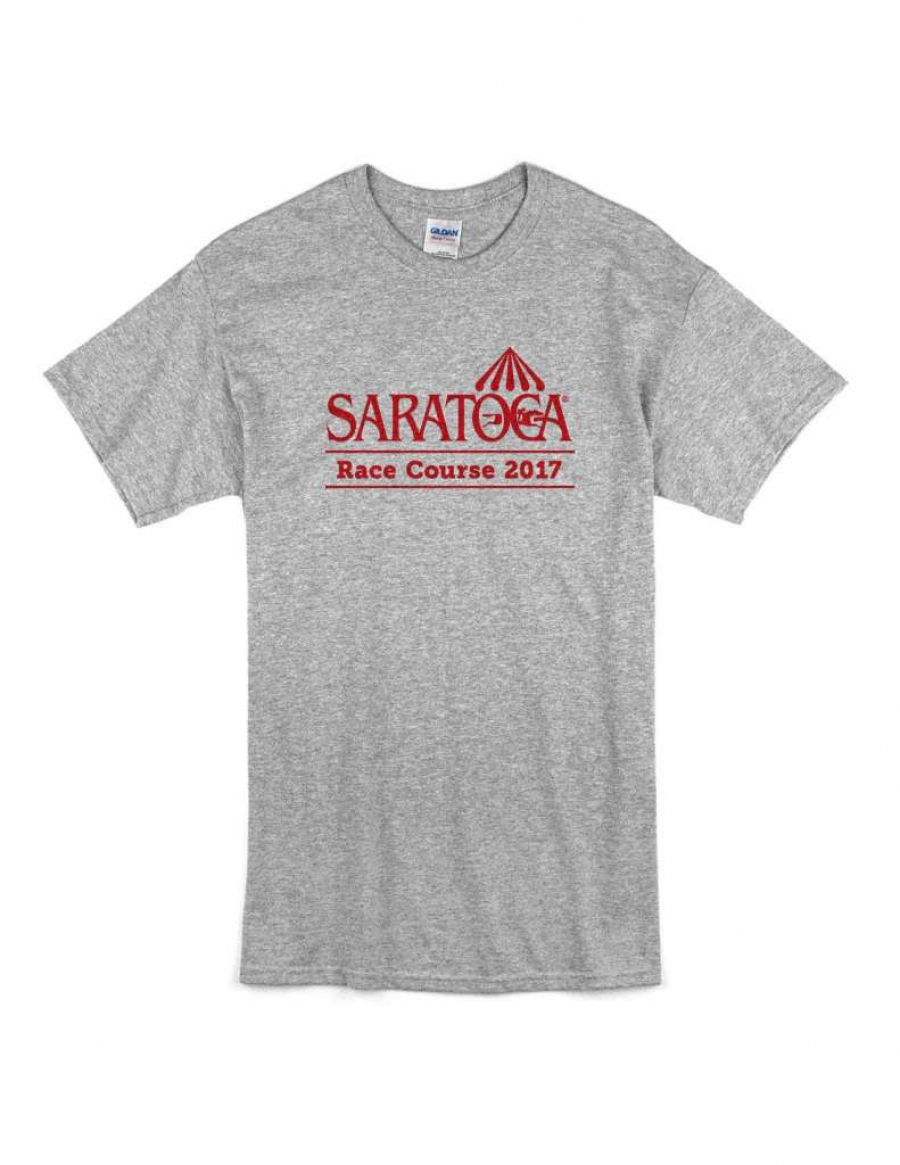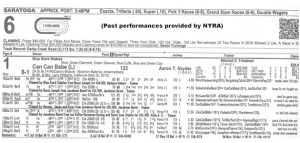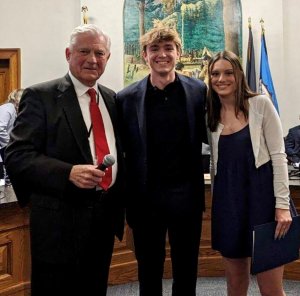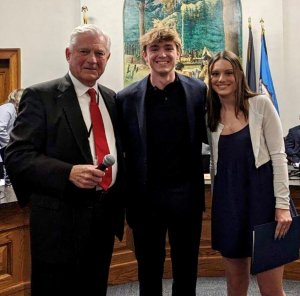Displaying items by tag: Saratoga Race Course
NYRA Announces 2017 Racing Season Giveaways
SARATOGA SPRINGS – The New York Racing Association, Inc. will continue its tradition of giveaways with four giveaway days scheduled for the summer 2017 meet at Saratoga Race Course. All giveaways are free with paid admission, while supplies last. The 2017 Saratoga Race Course premium giveaway schedule is as follows:
SARATOGA BASEBALL CAP: Sunday, July 23
The first giveaway of the 2017 season will pay tribute to the theme of opening weekend - Hats! Racing fans gather to receive a red and white Saratoga baseball cap, presented by Saratoga Casino Hotel. In addition to the Saratoga hat giveaway, the day's festivities will include the 26th annual Hat Contest, presented by Hat Sationa! By DEI.
SARATOGA SHORT-SLEEVE T-SHIRT: Monday, August 7
Racing fans will take home the second giveaway of the 2017 meet, a gray short-sleeve t-shirt featuring a red Saratoga Race Course logo. The giveaway corresponds with the weekly Berkshire Bank Family Mondays series, which features free children's activities and entertainment at the Berkshire Bank Saratoga Pavilion.
SARATOGA COOLER BAG: Monday, August 21
The season's penultimate premium giveaway - a red and black Saratoga cooler bag - will kick off the countdown to the $1.25 million Travers, which will be run for the 148th time on Saturday, August 26.
SARATOGA CLOCK: Sunday, September 3
Fans will celebrate closing weekend of the 2017 Saratoga meet with the final giveaway of the 2017 season - a Saratoga wall clock, presented by Foxwoods Resort Casino. The clock features an image of thoroughbreds racing down the stretch against the iconic Saratoga grandstand and clubhouse roofline.
Guests will be able to redeem up to three vouchers at Saratoga Race Course's giveaway redemption areas, including the one they receive with paid admission and the two additional vouchers they are able to purchase at the multiple admissions line beneath the grandstand.
The William Woodward You Never Knew
Saturday’s Woodward Stakes marks the sixty-third rendition of this historically important Stakes Race. The event was established in 1954 - just one year after the death of Mr. William Woodward Sr.
He was the owner of Belair stud - a name revered for breeding and racing top-level thoroughbreds for four decades. Mr. Woodward and his famed white with red polka dot silks would rule the horseracing world in the 1930s.
He would win two triple crowns in that span with Gallant Fox in 1930 and then Omaha in 1935. Belair almost pulled a hat trick with the great Nashua in 1955. Second to the mighty Swaps in the Kentucky Derby, he would come back to win the last two jewels easily.
Mr. Woodward was as at ease in his office as sole owner of Hanover National Bank, as he was at his desk as Chairman Of The Jockey Club, positions that he used to greatly enhance the reputation of American horse racing in comparison to its European counterparts.
I believe Mr. Woodward would be ecstatic to know the relevance of his namesake stake. Nineteen times the winner of this perennially important event would go on to be named horse of the year, names such as Sword Dancer, Kelso, Buckpasser, Forego, Affirmed, Spectacular Bid, Alysheba, Skip Away and Rachel Alexandra.
And let us not forget Holy Bull, a specimen so powerful that even Spain’s great matador “Manolete” would have been hard pressed to slow down this bull.
This is a roll call of those who have entered “The Pantheon of Champions” down through the ages.
Long after Belair closed its stalls and disbursed its remaining horse stock, The Woodwards would have one last hurrah. Bill’s daughter Edith would dust off the Belair silks one more time. This happened for one of the finest Thoroughbreds to ever grace the American Turf.
Damascus would thrill the racing world with battles of epic proportions pitted against his archrival Dr. Fager. It would be in the 1967 version of the Woodward Stakes where Damascus would prove his valor.
He would not only face Dr. Fager, but also the most regally bred champion in memory - Ogden Phipps’ Buckpasser, fittingly dubbed “The Race Of The Century.” Damascus put them both in his back pocket and along with it a well-deserved horse of the year trophy.
Years have passed, and The Woodward name is largely forgotten. The race is principally all that remains.
Then, in the spring of this year one more honor would be awarded to this great name in American racing. The National Museum of Racing and Hall of Fame named William Woodward Sr. as a “Pillar of the Turf.”
A distinction so well deserved, joining a select club including giants such as Alfred G Vanderbilt, John Hay Whitney, Paul Mellon, E P Taylor, August Belmont II and a few others who were the caretakers of horse racing in North America.
The advent of the Breeders Cup along with its huge purse structure and horse of the year ramifications have taken much of the luster off the Woodward and other historic races as well. Yet, it will always have the one distinction that separates it from all others… The Woodward name, a name that is synonymous with all that has made horse racing “The Sport Of Kings.”
Also, If you ever find yourself thirty miles southeast of Baltimore in Prince George’s County, just a few miles from the old Bowie Racetrack, you can still get a glimpse of Mr. Woodward’s masterpiece. Although most of the land has been sold off to developers and the tree-lined entranceways and perfectly manicured acreage may be long gone, the Belair Mansion and its renowned stables still survive.
Here you can walk your way into horse racing history as you tour these legendary grounds, a special place that for a few hours will take you back to the glory days of William Woodward and his beloved Belair Stud.
And, for any of the higher ups at NYRA that may read this, please consider the following:
- Make this race a Labor Day tradition.
- Race it at the classic distance of one and one-quarter miles (Saturday’s race is a mile and 1/8).
- Raise the purse to a richly deserved one million dollars.
It would be such a grand way to close out the future racing seasons here at the Spa. The late Mr. Woodward, who epitomized both class and the pursuit of excellence would expect, no make that demand - nothing less.
Weezie at the Flagpole What a Week!
‘Tho Mother Nature thankfully blessed us with perfect weather at the start of the week for the Fasig-Tipton Yearling Sales, by midweek she was cursing us with the dreaded “h-cubed muggies”, and by Fourstardave Saturday, she was defiantly laughing in our faces! The annual Sales hold a very special place in my heart. It is there that my lifelong love affair and fascination with horses began. Since my childhood home (our Presbyterian Church’s manse) was literally behind the yearling stables on the north side of Madison, I could walk out my backyard on Fifth, cross over what was then a real alley, slip under a gap in the fence, and be in seventh Heaven! If I knew then what I know now, however, I would never have been filled with the joyful innocence of that little girl who believed that one day a horse like these could be hers! On the second night of the sales, a filly by Medaglia d’Oro, (sire of the great Rachel Alexandra and current star Songbird) elicited a bidding war between Mandy Pope and B. Wayne Hughes that resulted in the Sales topper at $1.45 million! Ms. Pope, who has been building a powerful breeding operation in Ocala for some time now, along with the reputation as a fierce player and bullish foe, outdueled Mr. Hughes in a spirited battle, as they sat close by to each other! It never becomes old to watch in wonder as these beautiful babies are led out to the walking ring, often and loudly displaying their dismay with all of the attention, and to then see their potential suitors fight over them in the Sales ring like jilted lovers! In the very same location on Friday morning, pillars of the industry gathered for the Hall of Fame Induction Ceremony. For many years, I’ve relished being able to attend this wonderful event that has always been open to everyone, but thank goodness I had a media pass this year, because for the first time, it was closed to the public! Sadly, this resulted in a much smaller crowd than usual, for what was perhaps their most decorated class ever. Even though I’m sure the Hall anticipated huge ticket requests from the connections of this star-studded class, it was common knowledge that they were mostly fearful of PETA protesters ruining their event because of the scurrilous and baseless allegations of abuse that were leveled by Joe Drape in the New York Times against Steve Asmussen. Thank goodness these trumped up charges, based on a dubious and highly edited video that was manufactured by PETA, were found to be false after lengthy investigations by both the NY and KY Racing Commissions. After two agonizing years of waiting, their findings opened the door for the Hall to finally and rightfully induct him. Steve’s wife Julie, who began as a hot walker in his barn, introduced him, and remarked that the most important lesson he has shared with their three sons, is that you never give up, and that you wake up every morning and give it your all, because effort is everything! Although it’s been said that Steve is rather unapproachable and can appear aloof, in an extremely emotional and heartwarming acceptance speech, he showed us a very different side. He made it clear that he owes so much to his wife, who stood bravely by his side in spite of battling cancer during this ordeal, and to his Mom and Dad, (a former Jockey and Trainers who were in attendance) who raised him and his older brother Cash (a former Eclipse Award Winner as an Apprentice Jockey) in the small Texas town of Laredo, to believe in their ability to succeed, and to understand the importance of family and hard work. Choking back tears, he thanked his Mom for her faith in him, and his Dad for being the essence of a “true man”. He also made a point to thank his longtime Assistant, Steve Blasi, who had been the focus of the PETA witch-hunt. He went on to explain that this honor belonged to his entire team, and to his owners that never stopped believing in him, and most importantly, to the horses, including greats like Rachel Alexandra, Curlin, My Miss Aurelia, Untapable and Kodiak Cowboy. I can’t recall ever feeling any more devastated about an athlete’s injury than I did after hearing the horrible news of the bad fall Ramon Dominguez had taken on the hard inner track at Aqueduct, that January afternoon in 2013. I was absolutely heartbroken that this could happen to not only such an amazing talent, but to such an incredibly fine human being. Praying incessantly that he would recover, and hoping beyond hope that he would be able to return to the saddle, as the months passed, I remained optimistic. When the final verdict was announced, that the 3-time Eclipse Award Winner had to retire, I cried like a baby, and continued to tear up each time I saw him after he finally returned to the Track that following summer in Saratoga. But this year, and this day, are different, as the tears of sadness have turned to tears of joy for a man who has accepted his fate with the same humility, class and grace that defined his career. To make it easier on us who are easily moved to tears, he engaged us with hilarious stories during his acceptance speech, and showed us all why he will forever remain on top, no matter where life leads him. The ever-entertaining Tom Durkin, who once again served as the MC, introduced each honoree with his usual flair, and when he did so for Ann and Jerry Moss’ incomparable Zenyatta, he lamented that he was never able to call one of her races. Moss, the founder of A & M Records, (hence Queen Z being named after the album by The Police) and wife Ann, were understandably ebullient in their praise of, and thanks to and for their superstar, who wowed her throngs of fans with her diva-like prancing in the Post Parades, bigger than life personality, and devastating come from behind thrilling stretch runs. As has become my routine, I have saved the best for last, and I say this unapologetically and unabashedly with pride, because Rachel Alexandra is one of my very favorites of all time! I’ll freely admit that my opinion is based on the fact that I was so blessed to see her greatness in person several times, and from Churchill Downs in the Oaks, to Belmont in the Mother Goose, and ultimately on to Saratoga for her iconic Woodward, she thrilled me like no other, and left us all breathless and in tears! My heart stopped when we almost lost her in childbirth, and broke when we realized she would never be able to give birth again, but the unbelievable memories of her courage, grit and determination will remain alive in my heart and soul forever! As her compassionate yet understated owner, Barbara Banke, remarked during her acceptance speech on behalf of Rachel, it is her amazing courage that will define her legacy. In what was arguably his greatest race call, Tom Durkin reminded us of how Rachel’s heart stopping Woodward literally raised the rafters and moved the crowd with her gutsy victory! I will never forget standing at the rail on the finish line, with bodies ten-deep pressed up against me, and with tears running down my face, as she returned to the Winner’s Circle! Thank You, Rachel, for creating these unforgettable moments! Anticipating a storm of epic proportions, NYRA wisely cancelled the last six races on Saturday’s card, putting safety first, and all eyes then turned to Arlington Park. At this point, NYRA had to be very pleased with their fortuitous decision to provide bonus coverage that day from AP during their Saratoga Live show, and since Gabby Gaudet was already there to cover the big races, they smoothly transitioned from the mess at home, and turned it into a positive Win-Win for their new national programming. In spite of struggling in his Saratoga debut this Meet, with only three wins to his credit before he headed to Chicago, Florent Geroux, the almost-30-year-old French Jockey, had a day to remember at his old stomping grounds at AP! He racked up five wins from eight mounts, with four of them being Stakes, and two of these being Grade 1s. He owes a huge debt of gratitude to his hardworking Agent, Doug Bredar, (husband of TVG analyst Caton, and a former Racing Secretary at Churchill Downs and Gulfstream) for securing mounts for him three weeks out, on very live horses, that were favorites in every race he won! His Stakes streak began in the American St. Leger, on Mike Maker’s 4-5 favorite Da Big Hoss, and continued in the Grade I Secretariat for 3-year olds, aboard Chad Brown’s classy Beach Patrol, a son of Lemon Drop Kid. In the $700K Grade 1 Beverly D, FloG rode Chad’s even money favorite, Sea Calisi, stable mate and training partner of the great Lady Eli, to victory, and ‘tho he didn’t have the same luck in the Arlington Million, he closed out his streak in the Grade III Pucker Up, where with a continued stroke of good luck, he was awarded the victory on Chad’s 5-2 shot when the apparent winner was disqualified and dropped to third! The up and coming young Trainer from the UK, David O’Meara, further elevated his rising star when his 6-year- old Mondialiste, a son of the great Irish Sire Galileo, captured the Million. Although O’Meara only got his Trainer’s license six years ago, he has opened eyes with a win in the Woodbine Mile and a place in the Breeders Cup Mile already to his credit. In spite of still maintaining a four-win lead in the Jockey Standings with 31, it was a pretty rough week for Irad Ortiz, per his usual high standards. He was shut out on Wednesday, and again on his Birthday on Thursday, and also on the shortened card on Saturday. He was able to manage one win on both Friday and Sunday, but was also disqualified in Sunday’s feature, the Grade II Special, following a scary moment when his wayward 2-year-old bumped Ricardo Santana’s baby hard, who then in turn, bumped Johnny Velazquez, but fortunately, nobody went down! Javi Castellano was not involved, and ran down Irad aboard Gunneveral, who with an impressive turn of foot in the deep stretch, won in a thriller! This was Javi’s fourth Win of the day, and it moved him into a tie with Johnny for second in the standings at 24, but he would move ahead with a win on Monday to 25. However, this would be short-lived, as José Ortiz had a great Monday with four winners, too, and bolted ahead of them to 27! Joel Rosario remains in 5th with 18, and a streaking Luis Saez, who has been on fire since his huge 55-1 upset in The Test, now has 17! Manny Franco has 13, and after a big Wednesday for José Lezcano with three wins, he now has 10. ‘Tho FloG kept his hot hand going in the 1st Race Sunday, upon his return that morning from Chicago, he still only sits in 14th place with 4 Wins, proving how extremely difficult it is for any Jockey to venture into Saratoga and win! Chad Brown has a six-win lead over Todd Pletcher, 23-17, and Kiaran McLaughlin remains in 3rd with 9, while a red hot Rudy Rodriguez now has 8! I cannot wait for Saturday’s Alabama and the chance to see the magnificent Songbird once again! The delayed Fourstardave will also be on Saturday, and the cancelled Adirondack will now be run on Friday. See you next week!
The Seductive Siren Call of Exotic Wagers
In our opening week column, “Pari-mutuel – It’s You Alone Against the World”, we examined the pari-mutuel concept that is the cornerstone of Thoroughbred racing: Bettors at the track play against each other. “A long time ago in a galaxy far, far away”, pari-mutuel players had few wagering pool options. Wagering was limited to “flat bet” wagers on Win, Place, Show and Daily Doubles. It was simple and, by today’s standards, boring. These days it’s not so simple and for good reason. The century of lottery and Mega Ball became a model for race tracks to develop opportunities for bettors to make a score, perhaps even a life-changing score, through exotic wagering. Like casino jackpots, the multi-day carryovers on Pick 6 or Rainbow Six are the lure, the bait. Unlike casinos or Lotto, which make big winners poster children for wannabe winners, Thoroughbred racing rarely publicizes the identity of its big winners. But the betting public pays attention. The current exotic wagering menu at NYRA includes pools for making intra-race wagers such as Exacta, Trifecta, and Superfecta, in addition to Win, Place, Show and Daily Double. Said another way, inter-race is horizontal wagering between races, and intra-race is vertical wagering within a race. Inter-race pools are extensions of the original Daily Double concept. These include Daily Doubles throughout the card, Pick 3, Pick 4, Pick 5, Pick 6 and Grand Slam options. With vertical intra-race wagering, a bettor attempts to pick the correct order of finish for two, three, four or five positions in that same race. For the uninitiated, picking the exact order for the one-two finishers is the Exacta, the exact one-two-three finishers the Trifecta (triple), and the exact one-two-three-four finishers the Superfecta. Money flows into these separate wagering pools. (Note that in modern wagering the Exacta pool claims more money than the Win pool.) With horizontal inter-race wagering, a bettor attempts to pick only the winner for a particular sequence of 2,3,4,5 or 6 races. For serious recreational handicappers and professionals, exotic wagering is about leveraging opinion. Leveraging is important because Thoroughbred racing has been plagued by a shortage of horses, diminishing foal crops, and short fields, even at this 2016 Saratoga meet. Short fields yield post-time favorites at shorter prices. Exotic wagers permit bettors to turn 6-5 favorites and short fields into payouts of 3-1 or more. When favorites fail, as they often do, payouts increase. As with investing in the stock market, philosophy and style of play dictate when and where a bettor decides to invest a portion of his/her bankroll. The intra-race exotic pools are for the mildly adventurous. Inter-race pools are for risk takers and serious players seeking that “Fucillo Huge” score or life-changing event. There is a seductive simplicity to both vertical and horizontal wagers. The big “carry over” pools, which draw money, further entice. The Lottery has it’s “dollar and a dream.” Thoroughbred racing once had Harvey Pack’s clarion call to the next day’s card, “NOOOBody picked six!” Both invite one to wager a little in hopes of gaining significantly more. At the track, playing favorites is like backing blue-chip, dividend producing companies; playing long shot horses is akin to investing in penny stock. Playing exotic wagers allows the investor to marry the two, and sometimes that penny stock is a hit. There is the fan dance of exotic wagering. In the horizontals, all you have to do is pick the winners. That’s all? A handicapper who regularly picks 30% winners playing a pick 3 has a 30% x 30% x 30% chance of hitting the sequence, which is a .027% probability of picking three in a row. To increase chances of winning, pick players must “spread” in races to include both probable and possible winners. Sometimes a player must “buy” a race and cover “all” the runners. It can be expensive, but the returns might be generous. A “short pocket” or unwillingness to risk an uncomfortable amount of money forces inexperienced pick players to reduce the cost of a ticket. They regularly eliminate possible but less probable horses. A friend once lost a pick by eliminating an older horse named Federal Funds. He left the horse off his tickets “hoping Federal Funds would not run well today.” Of course the horse ran well. Also, pick players too often have winners at good odds in their pick but fail to make win bets on these winners, a lose-lose double whammy. Solid opinions in each leg of your pick series are required, even if it’s “no opinion”. Backing opinions and spreading in races where there is little or no opinion is a requirement for cashing pick tickets. Most pick players suffer losing streaks, some quite long. Ironically, the “key” to generous pick payouts is usually the odd horse, included or excluded from the ticket, which either makes or breaks your play. Bottom line: If you are reluctant to invest the bankroll it takes to cover near all the probable/possible winners in a pick play you have two options: pool resources with friends or save your bankroll for flat bets and intra-race wagers. Vertical intra-race exotics have the same requirement: attempt to cover all reasonable probable and possible horses that might fill your finish spots. Visualizing a pyramid helps understand the fact that only a few horses can actually win, several might actually race well enough to finish second, and almost any horse entered is possible to finish third or fourth. The pyramid has a wide base, as should your vertical exotic ticket. A trifecta ticket, for example, might be constructed to have the numbers 1 and 2 over the 1, 2, 3, 4, 5, 6. Take this same approach with superfectas. And, the horse named “All” (using the entire field) is sometimes an exotic player’s best horse. A common strategy for vertical exotics involves the concept of “boxing” tickets. To box means a multiple horse bet will pay if either horse in your ticket fills any slot. An Exacta box 1-2 will pay if either 1 or 2 runs first or second, but both must do so. A three-horse Exacta box of 1-2-3 pays if any of the three run first or second. Boxing is an easy strategy for new players to make this or any vertical exotic bet. Frankly, boxing is not the most efficient way to bet. Boxing actually sends an equal amount of money after unequal returns, not a positive investment strategy. But learning to wager efficiently comes with knowledge and experience. I believe the best chance to have a winning day is to leave the horizontal plays to others, unless you have a strong opinion in one or more races. My recommendation is to make win bets on mid-priced horses and exactas using your win horse as a “key” with logical favorites and other mid-priced horses. Such a play sounds and looks like this: “Win 4…Exacta 1, 2, 3 with 4…Exacta Box 1-2-4.” If number 4 wins, you win. If number 4 runs second to the 1, 2, or 3, you win. If either the 1-2-4 run first and second, you win. Some might argue I’m buying losing tickets. True, but the goal is winning while at the same time protecting the bankroll. The above play does just that and, if you are right, you get paid. Tom Amello began his Thoroughbred education over 50 years ago. In 1984, Tom created his own database of New York trainers and horses that became the foundation for the Saratoga selection sheet, Trackfacts. For over twenty years Tom produced and hosted original programming covering Thoroughbred racing for Capital District OTB Television. Tom conducts numerous handicapping seminars and workshops, including participation in “Count Down to…” programs at the National Museum of Racing and Hall of Fame and the “History, Horses and Handicapping” program at SUNY Empire State College’s Academy for Lifelong Learning. In 2013, Tom published Playing the Odds Board: Gateway to the Game ™, a guide that makes betting easier to understand and more fun for those new to Thoroughbred racing. Tom, with his daughter Kate, owns and operates the Brunswick at Saratoga Bed and Breakfast at 143 Union Avenue in Saratoga Springs. Contact Tom at This email address is being protected from spambots. You need JavaScript enabled to view it..
Here’s a way to Find a Horse to "Like"
At the racetrack, “Who da ya like?” is the question.
Deciding which horse or horses ya like and why it is critical to pari-mutuel success. The answer is in the track program.
Though at first intimidating, the track programs’ past performances are less difficult to understand than you think. The “key” is learning where to look and in what sequence. Handicapping is FUNdamental if you know the Four Cs: Connections, Capabilities, Current Form and Conditions.
CONNECTIONS: Determining the horse “ya like” begins with people. Horses race under the care of trainers; a jockey rides horses. Nothing earth shattering here, but the top 10 trainers and jockeys win most of the races. Current standings are printed in the track program. Start with that list. Then move to the past performances and determine how well each trainer and jockey is faring. In our program example, trainer Mitchell Friedman has run but a single horse; jockey Aaron Gryder has but one ride.
CAPABILITIES: What a horse has accomplished on the racetrack is recorded in a career box. The box presents lifetime starts and earnings, race record over the current and previous racing season, performance over today’s course, surface and distance. Wins, in-the-money finishes and performance by surface provide a picture of consistency or lack thereof. The career box suggests Can Can Babe is better on synthetic surfaces, wet tracks and turf than on dirt. Can Can Babe won 4/10 races in 2015. She earned a win a second thus far in 2016 as she rounds into form. Additionally, each horse earns speed and pace ratings for each effort it makes in a race. The higher the number the faster the speed or pace. Fast horses usually win over slower horses. But horses are not machines and figures earned vary. Speed and pace figures help you decide who is fast enough to compete and predict which might be faster today. Can Can Babe’s most recent speed figure is an 81. She has run a 99 in the past.
CURRENT FORM: Equine athletes are not machines. They are trained and conditioned in much the same way as most professional athletes. After each race, like most athletes, horses feel the effects of their effort. Most need a certain amount of time to recover. Some are capable of holding form through several races. Others, like NFL players sustaining minor injuries, need longer “vacations”, layoffs, before returning to the race wars. Simply put, horses round into form, perform and cycle out of form. If horses were people, I imagine they would often call in sick. Health and race fitness is the trainer’s job. Trainers recognize when horses require time to recover. Can Can Babe has been rested since her June 16 race after being claimed (purchased) by these connections. Racing dates are listed at the far left of the past performance box. The dates indicate how often each horse makes it to the races. Lines between the dates indicate time away in recovery. Additionally, each line indicates track condition, surface and distance, fractions and final time of each race, the age level and sex of the runners, the class level (a topic for another time), pace and speed ratings, and the running position from start to finish. Some horses race better over different tracks, surfaces and distances. Some race well after a layoff; others don’t. Can Can Babe won once following a 30-day rest from December to January. Finish position is a reflection of current form against that day’s level of competition. Horses finishing in-the-money or in the front half of the field in their most recent races can be viewed as being in good form. Consistent rear-half finishers are cycling either out of form, overmatched at the class level, or cycling back into form. Can Can Babe returns to racing after a layoff since June 16.
CONDITIONS: Because it is so important to trainers, handicappers should pay attention as well. The Racing Secretary writes a book of races from which trainers will opt to race. This Condition Book is a form of racetrack bible. The intent is to bring horses of near equal ability together to race for purse money. Some races are open to all. Most races restrict or bar certain horses. The specific race condition identifies which horses may or may not enter to run. Why might horses be barred from running in a race? To keep young developing horses together, and to level the playing field for elders. If not, the better horses would always beat up on and defeat the lesser. So, the intent of the condition is to invite eligible horses of relatively equal ability to enter. Conditions are not unusual in sport. Professionals always win open golf or tennis tournaments; professionals are barred from amateur tournaments. Today’s condition example is a claiming race. All horses entered are for sale for $20,000 and may be bought by licensed horsemen through a “claim” process. This race is for females (Fillies and Mares), ages Three Years old and Upward. Three-year-olds carry weight of 120 pounds; older carry 124 pounds. Horses carry weight plus the jockey. Elders carry more than three-year olds. In this condition, Non-winners Of Two Races in 2016 are allowed to carry 2 pounds less. Non-winners of A Race in 2016 are allowed to carry 4 pounds less. Good horses that win are “penalized” and carry more weight than ‘Non-winners’, a euphemism for Losers. Weight carried is a concern for trainers. They seek race conditions that give their horse a weight advantage. Horses that best fit the written restrictions of the condition don’t always win, but are always contenders to win.
That’s why it pays to learn to read and understand the race conditions. Mastering the FUNdamental Four Cs of Connections, Capabilities, Current Form and Conditions will help you answer the question, “who da ya like?”
Tom Amello Tom Amello began his Thoroughbred education over 50 years ago. In 1984, Tom created his own database of New York trainers & horses that became the foundation for the Saratoga selection sheet, Trackfacts. For over twenty years Tom produced and hosted original programming covering Thoroughbred racing for Capital District OTB Television. Tom conducts numerous handicapping seminars and workshops, including participation in “Count Down to…” programs at the National Museum of Racing and Hall of Fame and the “History, Horses and Handicapping” program at SUNY Empire State College’s Academy for Lifelong Learning. In 2013, Tom published Playing the Odds Board: Gateway to the Game ™, a guide that makes betting easier to understand and more fun for those new to Thoroughbred racing. Tom, with his daughter Kate, owns and operates the Brunswick at Saratoga Bed & Breakfast at 143 Union Avenue in Saratoga Springs. Contact Tom at This email address is being protected from spambots. You need JavaScript enabled to view it..
The Most Difficult Race Meet in The World
Saratoga is also the Graveyard of Many a Wallet
Could you hear the weeping? It began approximately two minutes after track announcer Larry Collmus led the crowd in the annual “And they’re off at Sarato¬¬ga.” When #1 Clifton Pleasure (6-1) angled out off the rail to run down Battle of Evermore (5-1) and crossed the finish line ahead of favored Jet Black in the July 22nd nine furlong opener, most players here and watching from around the country were officially re-introduced to the most difficult race meet in the world.
So why and how is this race meet we love so difficult? Let me count the ways.
1) For starters, Saratoga is a boutique meet for the fashionable and sophisticated. Thoroughbred aficionados (and that includes serious recreational handicappers) point to this race meeting. The prestige of winning a race (and cashing tickets) at Saratoga will forever draw the best horses that have been bred to the best race mares. I was in the paddock some time back with a group of West Point Thoroughbred partners. When jockey Mike Smith shook hands with one partner, this gentleman leaned in and said in a graveled tone, “Get me the picture, Mike.” To a certain degree, for those directly involved, winning a race, any race, at Saratoga is like the Super Bowl or seventh game series final in other major sports…extremely competitive, and everyone wants that picture.
2) The racing season at Saratoga has always been compressed into a limited calendar. My personal experience began when Saratoga was the “August Place to Be.” It was a frenetic 24-day happening. Most trainers and owners took one shot with their horses during the meeting. Some horses thrived on the dirt or turf surfaces; others failed to handle either the August heat or the heat of competition. A few sharp trainers squeezed a second run from horses. Those horses able to win once often returned to repeat their winning efforts, creating a “horse-for-the-course” mythology grounded on the efforts of runners like Quick Call and Fourstardave. A win or near-winning effort over Saratoga dirt or turf continues to be powerful medicine. The current 40-day stand gives connections more opportunities to race. Each year more horses become potential horses-for-the-course. Leave previous Spa winners, regardless of current form, off your tickets at your own peril. It’s a tough meet.
3) Saratoga is synonymous with juvenile racing. The Saratoga race meet offers breeders and owners of juvenile colts and fillies the opportunity to showcase their stock. From sprint dashes for non-winners to end of meet stakes at longer distances, young horses begin the sorting and selecting process for the Triple Crown and major Filly races of their sophomore year.
4) Saratoga draws from all the major racing circuits around the country. Also, connections with runners from lesser tracks ship in to test the deep waters. Sometimes they snare a purse and a prize. Maiden Special Weight races for unraced and lightly raced juveniles are particularly difficult. Like a spiritualist reading tea leaves, one must consider nature (pedigree) and nurture (trainers). The few specialists in pedigree, physicality and supporting trainer stats might have an advantage over a much less informed public. But knowledge and hard work only reduce the degree of difficulty that is the Saratoga meet.
5) Turf racing around two-turns (and two turf courses!) is another feature of the Saratoga race meet. As important as juvenile racing, the very nature of turf racing makes this premier meet more difficult. Sprinting on dirt or turf is the polar opposite of distance running over turf. Sprinting is all about gaining position in the early going. Distance turf racing is about gaining inside position and saving ground to avoid racing wide. Distance turf racing is about position among the herd down the straight, then into and around a turn. Unlike the sprinter’s beginning dash, distance turf racing culminates in a late sprint to the wire. The nature of turf racing leaves betting favorites more vulnerable than their sprinting counterparts. Add pedigree analysis to the equation, whether the horse will perform well over turf, and the level of difficulty increases further. Turf fields are usually full fields, sometimes with 14 meeting the starter. Contention often runs deep - the process of elimination difficult. Oy!
6) And, of course, Saratoga’s often quirky weather pattern (Hazy, Hot and Humid with a 30 percent chance of a monsoon) wreaks havoc on turf racing. Races switched or rained-off from turf-to-dirt are maddening to handicappers. First, there are the scratches. Next, there is the search for horses meant to run on turf that can handle a track labeled “off”. Finally, certain horses were originally entered in hopes the race would be rained off. Yeesh!
7) Intent increases the difficulty of the Saratoga meet. Everyone wants to win. Everyone shops a spot where they can be competitive enough to win. Many prepare horses months out hoping their horse will peak during Saratoga. Such preps often hide or darken form, nothing unethical or shameful, but another factor that makes this meet an absolute killer.
8) Finally, Saratoga brings together the best of the best in terms of jockey colony and trainers. Top riders from far away circuits struggle to obtain and keep business at Saratoga. Lesser-known or obscure trainers sometimes get the best of a Todd Pletcher, Chad Brown or Steve Asmussen…but not with any regularity. These irregular winners are often head scratchers that bust up more logical plays. Yeesh again!
Yes, the annual race meet at Saratoga is a difficult and tough meet. It’s tough on breeders, owners, trainers, jockeys, backstretch employees, and handicappers. But these folks love being in Saratoga, competing at Saratoga, winning and, yes, non-winning at Saratoga…after all, a difficult day at Saratoga is better than an easy day anywhere else.
Tom Amello began his Thoroughbred education over 50 years ago. In 1984, Tom created his own database of New York trainers and horses that became the foundation for the Saratoga selection sheet, Trackfacts. For over twenty years Tom produced and hosted original programming covering Thoroughbred racing for Capital District OTB Television. Tom conducts numerous handicapping seminars and workshops, including participation in “Count Down to…” programs at the National Museum of Racing and Hall of Fame and the “History, Horses and Handicapping” program at SUNY Empire State College’s Academy for Lifelong Learning. In 2013, Tom published Playing the Odds Board: Gateway to the Game ™, a guide that makes betting easier to understand and more fun for those new to Thoroughbred racing. Tom, with his daughter Kate, owns and operates the Brunswick at Saratoga Bed and Breakfast at 143 Union Avenue in Saratoga Springs. Contact Tom at This email address is being protected from spambots. You need JavaScript enabled to view it..




 How to resolve AdBlock issue?
How to resolve AdBlock issue? 




































